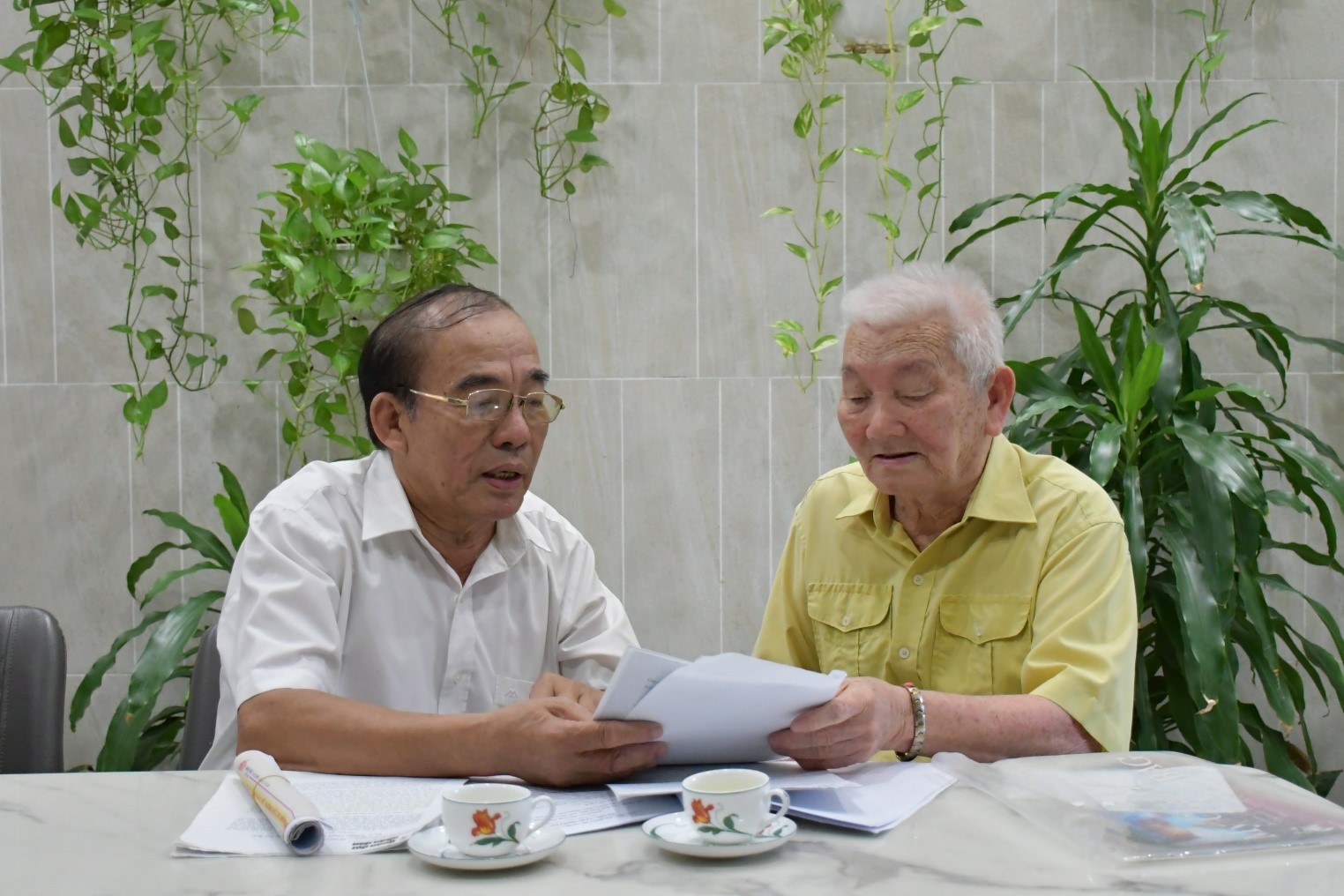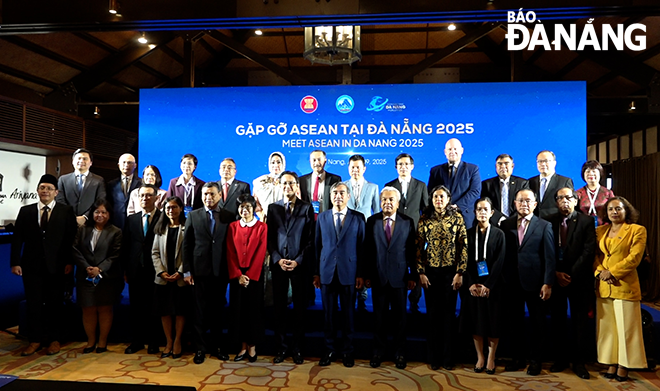The lighthouse of the unnumbered fleet
In a morning at the end of October, Da Nang welcomed a distinguished guest: Colonel Phan Van Cuc, former Party Secretary and Deputy Commander of Naval Region 3. Contrary to our expectations, he didn’t speak much about his military achievements or career. Instead, with teary eyes, he recounted stories about Lieutenant Colonel Vu Tan Ich, the legendary captain of nine unnumbered ships, and he is now 94 years old.
 |
| Captain of the unnumbered ship, Vu Tan Ich (right), discussing with Colonel Phan Van Cuc some historical documents about the Ho Chi Minh trail at sea. Photo: T.Y. |
The Imprinted Anchor on Forehead
A touching conversation with Colonel Phan Van Cuc guided us to the home of the legendary captain of the unnumbered fleet, nestled within a narrow alley of Nguyen Tri Phuong Street. Outside, the hum of traffic flowed uninterrupted, but inside, time seemed to stand still, allowing the stories of waves, winds, and the arduous and challenging sea voyages to unfold with poignant clarity.
Memories of the captain who experienced nine times of leading unnumbered ships carrying weapons and ammunition from the North to support the Southern battlefield trace back to early 1963. At that time, his steps still wandered through the Truong Son forests, following the covert liaison routes to the North for his mission.
At the Ministry of Defense headquarters at 83 Ly Nam De Street, Hanoi, the 33-year-old party member from Chau O Town, Binh Son District, Quang Ngai Province, operating under the alias Hong Hai Chien, was entrusted with a critical role. He was appointed as both captain and political instructor, as well as Party cell secretary of Team 6 (also known as Ship 56, part of the Military Transport Group 759, the precursor to today’s Naval Brigade 125). His mission is to deliver weapons to the South via the Ho Chi Minh trail at sea.
Before embarking on his mission, once a week, Captain Vu Tan Ich was taken by Lieutenant General Doan Hong Phuoc, Head of Group 759, to visit Bach Dang 3 Shipyard in Hai Phong. There, he would look at the Ship 56, a 100-ton vessel being rushed to completion in preparation for its maiden voyage.
After a long wait, on the night of April 12, 1964, 12 officers and crew members were brought to the Ship 56 anchored in the Naval Port of Group 130 in Hon Kem Bay (Quang Ninh). Their mission was to transport nearly 50 tons of weapons to Bac Lieu.
Disguised as a fishing boat, the iron ship commanded by Captain Vu Tan Ich cut through the waves towards the southern seas. Throughout the long journey, the ship numbered 56 frequently altered its course to evade enemy patrols and detection. Whenever seeing the shadow of an enemy ship from far away, the crew quickly stopped the vessel, shut down all lights and engines, and pretended to be fishing.
On their first approach to Ben Tre, the sea was rough, when four enemy ships fired flares, and searchlights scanned the water surface. The sailors cautiously navigated forward, using poles to measure depth while remaining ready to fight. The situation was tense as at 3am the ship could not establish contact with the shore. After consulting with the Party Committee, Captain Vu Tan Ich ordered the ship to retreat to international waters, maintaining its disguise as a fishing boat while waiting for the right moment.
“The ship had no choice but to return to international waters, where every passing second felt like an eternity. Everyone understood that each move could mean survival—or the end, a failure. In the pitch-black darkness of the sea, I recalled the words of Lieutenant General Tran Van Tra, Deputy Chief of Staff of the Vietnam People’s Army, “Cling the shore, and you will triumph. Cling the shore, and you will achieve victory, because the rivers and seas are ours, our country belongs to our people”.
I also remembered the words of Naval Commander Nguyen Ba Phat during the farewell ceremony, “Wherever you go, whatever mission you undertake, always remember the anchor etched in your mind and use it to navigate your way”. Captain Vu Tan Ich recounted with deep emotion the challenges of his first sea mission that did not go as smoothly as hoped.
The following night, Captain Vu Tan Ich directed the ship southward, searching for signals from the "shore support forces". It wasn’t until after 3 a.m. that they spotted a fishing boat casting its nets near Vam Lung (Ca Mau). After exchanging coded signals and confirming their alignment, He was delighted when the ship had entered a liberated zone. However, at that time, the ship became stranded on a sandbar, forcing the crew to camouflage it by spreading fishing nets and dried fish on deck. They were also instructed not to engage, despite enemy planes circling overhead.
When the tide rose, the ship navigated into dense nipa palm forests to unload its cargo. Despite the stormy seas of the season, Ship 56, after completing its mission, set out to return to Do Son Port (Hai Phong) as quickly as possible. To lower its visibility, the crew loaded some rice and clusters of nipa palm fruit onto the ship. The round-trip journey took less than ten days, earning praise from Lieutenant General Tran Van Tra as the “ship that left last but returned first”. At the time, Ship 56 outpaced iron ship 1 and four wooden vessels, Phuong Dong 1, 2, 3, and 4, which were still stationed in the South.
After the initial success, Captain Vu Tan Ich continued to lead 8 more unnumbered ships between 1964 and 1967 to deliver weapons to the battlefields of Eastern and Southwestern Vietnam. Not every mission reached its destination safely. One ship was caught on coral reefs in Hoang Sa, forcing the crew to offload the cargo and scuttle the vessel to leave no trace. Another ship had its oil pipe broken by a wave in the middle of the road, making it unable to pump oil to the steering engine. It drifted at sea for two weeks but could not report the incident to the mainland due to the top-secret nature of the mission.
The most heartbreaking episode involved Ship 198, which departed Northern Vietnam on the night of July 6, 1967, and carried nearly 100 tons of weapons, including ammunition, grenades, rifles, explosives, anti-aircraft guns, and AK-44s. Tragically, the ship was detected by U.S. Market Time forces (deployed by the US military to prevent the activities of the unnumbered ship) when it was just 6 nautical miles away from Ba Lang Port in Quang Ngai.
A Lingering Sorrow
| No longer part of the unnumbered fleet after the failure of Ship 198, Captain Vu Tan Ich remains a guiding beacon in the hearts of his comrades. The unnumbered ships he led have become legendary. Each trip contains life-and-death moments, silent sacrifices, and the constant peril of walking the fine line between survival and death. These voyages stand as a testament to the patriotism and courage of generations of Vietnamese naval soldiers, who paved the maritime extension of the Ho Chi Minh Trail with their unwavering resolve. |
Mr. Ich said that was the most painful memory of his life. When the iron ship was discovered, the U.S. Navy deployed five large ships to capture the ship and its crew on Sa Ky River (Quang Ngai). Under relentless attack, Mr. Ich and his crew fired back with a 12.7 mm heavy machine gun while manoeuvring to reach the shore. However, overwhelmed by enemy firepower, Ship 198 caught fire. At that time, Captain Vu Tan Ich had to make a heart-wrenching decision to abandon the vessel. Leading some crew members, he swam toward the shore, after sending the deputy captain, Pham Chuyen Nghiep, and political commissar Huynh Ngoc Thach to stay behind and destroy the ship with explosives. Yet, their efforts failed as the ship did not explode as planned.
Two comrades were sacrificed. The failure of 198 (or Skunk Alpha - Alpha Weasel as Americans call it) led Captain Vu Tan Ich's military career into a different direction. Following the tragic incident, he was reassigned to a naval commando unit, where he served as Battalion Commander of the torpedo clearance fleet. Later, he became Chief of Staff for Brigade 171, and participated in the liberation of Da Nang city in 1975 and worked in Military Region 5 until his retirement with the rank of Lieutenant Colonel.
Although he has not been with the unnumbered ships since the failure of ship 198, Captain Vu Tan Ich remains a guiding beacon in the hearts of his comrades. The unnumbered ships he led have become legendary. Each trip contains life-and-death moments, silent sacrifices, and the constant peril of walking the fine line between survival and death. These voyages stand as a testament to the patriotism and courage of generations of Vietnamese naval soldiers, who paved the maritime extension of the Ho Chi Minh Trail with their unwavering resolve.
Over the years, in the meetings of the Traditional Association of the Unnumbered Ships Club - Brigade 125 of the Navy, his comrades always mentioned him with pride, affection, and deep respect. And above all, in their hearts, they always wondered why a brave commander with many achievements like Captain Vu Tan Ich had not yet been awarded the title of Hero of the People's Armed Forces by the State. Numerous review meetings and proposals from the Traditional Club advocating for his recognition have been submitted, but to this day, there has been no response.
At the age of 100, Mr. Ho Tang Nhuan, the senior sailor of ship 56, currently living in Tho Quang ward (Son Tra district) still has a lingering feeling about the captain he respects. "The second iron ship with the code name 56 left the port quite primitively, equipped with only a compass, a map, a wooden ruler, binoculars, and a flashlight to coordinate signals with the shore. The ship departed in secrecy. The entire crew carried no trace of their origin from the North and left behind even personal keepsakes on the shore".
“Not only was he the captain, Mr. Ich was also the lighthouse of the entire ship. In the most critical moments, when life and death were separated by a hair's breadth, and when enemy ships patrolled nearby, it was his decisiveness and courage that kept the crew's spirits high, found solutions, and led the ship safely to Vam Lung”, Mr. Nhuan recalled his first mission with emotion after he was transferred from Ha Long Fishing Fleet to join Captain Vu Tan Ich in transporting 50 tons of weapons to Bac Lieu by sea.
In his rare old age, Captain Vu Tan Ich now lives in the love and respect of his comrades, even from naval soldiers who did not participate in the perilous journeys of the unnumbered ships convoy.
In his story, Colonel Cuc said that if because of this problem, the awarding of the title of Hero of the People's Armed Forces has not been considered by all levels, it would be a great injustice to Lieutenant Colonel Vu Tan Ich. Because the information about the chase and the detailed plans of the US military were reported in detail by the US side in the English article "Victory on the Sa Ky River", which partly clarifies why the ship could not self-destruct: “During the battle of the Alpha Weasel, the mortar shell accidentally triggered the detonation of 2,000 pounds of NTN explosives; otherwise, the US military would have suffered great losses if the Alpha Weasel had exploded according to their plan”.
The historical story has become somewhat clearer. However, the feelings of loss and sacrifice still linger for those involved. Every time they recall it, those emotions resurface, like a wound that has never fully healed.
Reporting by TIEU YEN – Translating by HONG VAN








